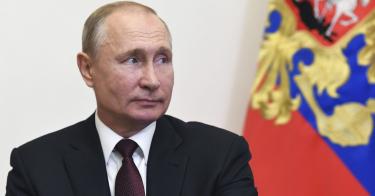Geopolitics doesn’t rest, not even for a global pandemic. Despite significant economic setbacks resulting from U.S. sanctions, Russia continues its drive to complete the Nord Stream II pipeline.
As Moscow makes a last-gasp effort to pull this geopolitical Trojan horse across the finish line, it’s imperative that the administration keep up U.S. pressure, which could potentially derail the pipeline once and for all.
The Nord Stream II (NSII) natural gas pipeline would connect Germany with Russia. It is neither economically necessary nor geopolitically prudent. However, it would greatly increase European dependence on Russian gas, magnify Russia’s ability to use its European energy dominance as a political trump card, and specifically undermine U.S. allies in Eastern and Central Europe.
Construction on NSII began in May 2018. The project envisions two pipelines carrying natural gas from facilities operated in Ust Luga, Russia, by state-owned Gazprom to Greifswald, Germany.
Russia currently supplies around 40% of Europe’s natural gas, utilizing the existing Nord Stream I pipelines and overland pipelines via Belarus and Ukraine. Completing Nord Stream II would allow Russia to decrease gas flows via its overland pipelines in favor of the Baltic Sea routes of Nord Stream I and II—and Gazprom has clear plans to do exactly that.
This would make Europe far more vulnerable to Russian energy blackmail. Analyst Mikhail Korchemkin notes that a completed NSII would allow Putin "to quickly cut off over 80 percent of the supply of Russian gas to the European Union on short notice.” This would give Putin tremendous leverage to pressure European leaders to acquiesce to his geostrategic aims; Germany’s growth as the continent’s key natural gas transit hub could also buy Russia some political space for maneuver in a critical U.S. ally.
NSII would also benefit Russia by staunching the flow of money which eastern European nations, like Ukraine, collect via transit fees—money which Kyiv utilizes to defend itself from Russia’s continued illegal occupation of Crimea and the ongoing war in Ukraine's Donbas.
Nord Stream II would also allow Russia to stifle competition from liquefied natural gas (LNG), which has made strides in the European Market in recent years. The U.S. supplies only 3.5% of Europe’s natural gas, but the U.S. government credits American LNG with saving “European consumers $8 billion by enabling them to negotiate lower prices with existing suppliers.”
In the U.S., strong bipartisan opposition to Nord Stream II led in part to the inclusion of sanctions in the National Defense Authorization Act (NDAA) for Fiscal Year 2020. One section of the action, the Protecting Europe’s Energy Security Act, authorized secondary sanctions against companies involved in laying the Nord Stream II pipeline, which did not “immediately cease construction-related activity” in a “good-faith wind-down.”
As a result, the near-irreplaceable Swiss Dutch company Allseas suspended its construction work on the pipeline. It had been using two ships to lay 96% of the pipeline. In January, Putin admitted U.S. sanctions had delayed the completion of Nord Stream II but promised to complete the pipeline nonetheless.
Less than 100 miles of the pipeline remains to be completed. Eager to finish the job while the world’s attention remains focused on the pandemic, Gazprom plans to use two of its own ships—the pipe-laying Akademik Cherskiy and the crane ship Fortuna—to lay the remaining route.
However, as Jamestown Foundation analyst Margarita Assenova recently noted, this scheme is fraught with technical difficulties, environmental concerns, and regulatory hurdles. The Akademik Cherskiy “is only equipped for laying pipes up to 32 inches in diameter, while the twin Nord Stream Two pipes are wider, 48 inches in diameter. Thus, the pipe-laying barge Fortuna will have to be physically attached to the Akademik Cherskiy to complete the job. Such a solution carries its own technological and environmental risks, particularly if the Fortuna needs to be anchored near World War II-era munitions dumps in the Baltic Sea; thus, its involvement will have to be approved by the Danish Energy Agency.”
In whose territorial waters the pipeline runs, Denmark has not issued permits to renew construction since the Fortuna lacks the dynamic positioning system required by Danish law. Nord Stream II’s timeline is further truncated by summer closures of parts of the Baltic for fish spawning.
Nord Stream II also has recently encountered legal setbacks. The General Court of the European Union upheld an EU gas directive requiring separate ownership of gas and transmission lines. Gazprom has been seeking avenues to circumvent the directive for months, such as setting up a purportedly independent subsidiary.
This week, U.S. Ambassador to Germany Richard Grenell indicated that further sanctions were likely to be announced, with Gazprom in the crosshairs. That’s a good thing. For the U.S., keeping Nord Stream II from being completed must remain a priority. The pipeline, which is opposed by most European nations, is a political project which greatly undermines collective defense in Europe.
This piece originally appeared in RealClear Defense



